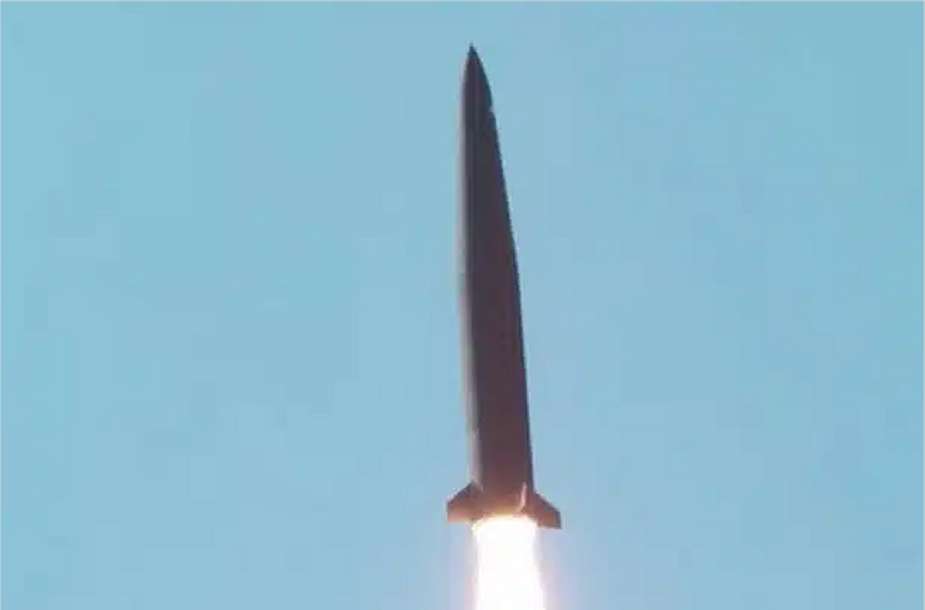South Korea successfully tests nuclear-equivalent Hyunmoo-V missile
According to Mason on January 7, 2024, South Korea recently conducted missile tests in December 2023, launching the Hyunmoo-IV-1 and Hyunmoo-V strategic missiles. The Hyunmoo-V missile is reported to have more than 11 tons of firepower and plans to equip it with Maneuverable Re-entry Vehicle (MaRV) and Multiple Independently Targetable Re-entry Vehicle (MIRV) capabilities.
Follow Army Recognition on Google News at this link

The Hyunmoo-V missile has the potential to carry one of the world's largest warheads, weighing up to 9 tons, potentially mimicking the effects of nuclear weapons. (Picture source: South Korea MoD)
The Hyunmoo-IV-1 and Hyunmoo-V missiles, also known as the 'High Power Missile' (HPM), are designed to effectively neutralize underground facilities. The Hyunmoo-V missile has a unique design meant to detonate above these facilities, rendering them ineffective by burying them completely. Its solid propellant is powerful enough to require a cold-launch mechanism. Moreover, all Hyunmoo ballistic missiles are equipped with evasion systems designed to counteract air defense systems used by North Korea and other countries.
The Hyunmoo-V missile weighs 36 tons and follows a 'Lofted trajectory,' flying through the exosphere to enhance its penetration capability. South Korea has also conducted tests on hypersonic cruise vehicles, with ongoing development efforts focused on the Hypersonic Glide Vehicle (HGV).
According to sources, South Korea currently has a stockpile of over 20 Hyunmoo-V missiles, and mass production of the HPM series missiles is underway. South Korea uses the term 'Extreme Precision, High Power Missile' instead of more conventional designations like IRBM (Intermediate-Range Ballistic Missile) or ICBM (Intercontinental Ballistic Missile).
According to the Chosun Ilbo on December 29, 2023, the South Korean Minister of National Defense, Shin Won-sik, recently announced the successful test launches of the Hyunmoo-IV-1 and Hyunmoo-V missiles by the South Korean Army, without disclosing the exact timing of these tests. However, as reported by M51.4ever on January 7, 2024, information about these tests is often disclosed through NOTAMs (Notice to Airmen), which are notifications issued to ensure the safety of airspace and aircraft during missile-related activities.
NOTAMs are issued to inform pilots about restricted or hazardous airspace regions associated with missile launches. These NOTAMs contain information such as geographical coordinates, altitude limits, duration, and other pertinent details about the restricted airspace.
M51.4ever's analysis of NOTAMs activated in South Korea in December 2023 suggests that the Hyunmoo-V test likely took place either on December 26th or 27th. The test was conducted at a test range near Jeongjuk-Ri village on the West Coast, targeting a group of islands approximately 185 km south of the launch point, a distance almost identical to the separation between Seoul and Pyongyang. However, South Korea's missiles have not yet been proven in combat, unlike North Korea's Hwasong-11/KN-23 ballistic missile, which was reportedly used by Russia in Ukraine.
In recent years, South Korea has made significant investments related to the 3K Defense System, designed to preempt North Korean nuclear launches and counterattack missiles, with the capacity to intercept projectiles at altitudes up to 60 km. Scheduled to be established in 2024, South Korea's Strategic Command will oversee this 3-axis defense system, consisting of three platforms and concepts, all starting with the letter 'K': the 'Kill Chain' component, Korea Air and Missile Defense (KAMD) system, and Korea Massive Punishment and Retaliation plan (KMPR).
The 'Kill Chain' component ensures a swift response to North Korean missile threats, with an emphasis on detecting and engaging targets, including North Korean nuclear and missile facilities, before they can launch their missiles. The 'Kill Chain' component is said to have the capability to target mobile missile launchers within 30 minutes.
The Korean Air and Missile Defense (KAMD) system, responsible for intercepting incoming North Korean missiles, focuses on providing multi-layered defense for critical facilities and population centers, intercepting air, missile, and artillery threats. In the KAMD system, the domestically produced Long-Range Surface-to-Air Missile (L-SAM) air defense system will be used as an upper-tier interceptor for a layered defense.
Finally, the Korea Massive Punishment and Retaliation Plan (KMPR) serves as a deterrent strategy, assuming that a North Korean attack, nuclear or not, has already been initiated. In response, South Korea would retaliate with a combination of precision missiles, advanced aircraft, and potentially special operations forces, targeting various objectives, including countervalue, counterforce, and leadership decapitation strikes.
The 3K Defense System encompasses various military capabilities across different South Korean branches, such as the Army's Strategic Missile Command's Hyunmoo family of missiles (in both Kill Chain and KMPR), the Air Force's PAC-3s, F-35A jets, and Global Hawk surveillance aircraft, and the Navy’s 3,000-ton submarines with sub-launched ballistic missiles and KDX-III Aegis destroyer-based SM-2 missiles, among others. Additionally, South Korea's future military surveillance satellites, cyber warfare, space-focused forces, and special forces units will be integrated into this defense network.
Once deployed, the Hyunmoo-V is expected to play a central role in South Korea's Korea Massive Punishment and Retaliation (KMPR) operational plan. According to the information available, the Hyunmoo-V has earned the nickname "monster missile" due to its capabilities. With a thrust of 75 tons, it has the potential to carry one of the world's largest warheads, weighing up to 9 tons, capable of causing significant damage to deeply buried tunnels and bunkers, potentially mimicking the effects of nuclear weapons.
Additionally, the Hyunmoo-V features incredible speed, descending upon its target at speeds 10 times faster than the speed of sound. Although the exact maximum range of the Hyunmoo-V remains undisclosed, experts speculate it could potentially reach distances of up to 3,000 kilometers or even farther, placing it in the category of intermediate-range missiles. For example, the Hyunmoo-V's specifications, including its warhead weight and thrust, make it similar to the US Minuteman 3 intercontinental ballistic missile (ICBM), although the Hyunmoo-V is believed to be a two-stage ICBM.
- Hits: 5724
















